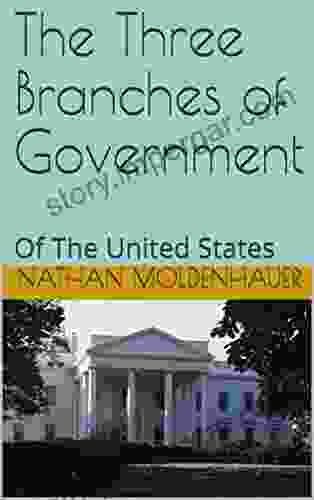Understanding the Framework of Governance: The Three Branches of Government

The concept of separation of powers is a cornerstone of modern democratic societies. It entails dividing the powers of government into distinct branches to prevent the concentration of excessive authority in any single entity. In the United States, the Constitution establishes three separate but cooperating branches of government: the legislative, executive, and judicial. This system, known as the "three branches of government," ensures balance, accountability, and the protection of individual rights.
The Legislative Branch
The legislative branch, comprised primarily of the United States Congress, is responsible for making laws. Congress is composed of two chambers: the House of Representatives and the Senate. The House has 435 members, each elected from a specific district within a state, while the Senate has 100 members, two from each state.
5 out of 5
| Language | : | English |
| File size | : | 2886 KB |
| Screen Reader | : | Supported |
| Print length | : | 642 pages |
Powers of the Legislative Branch
- Making laws: Congress has the exclusive power to create new laws and amend or repeal existing ones.
- Levying taxes: Congress has the authority to impose taxes to fund government operations.
- Appropriating funds: Congress controls the power of the purse, approving the allocation of funds for various government programs.
- Declaring war: Only Congress can declare war and authorize the use of military force.
- Impeachment: The House of Representatives has the sole power to impeach (accuse) the president, vice president, or other high-ranking officials for serious crimes.
The Executive Branch
The executive branch, headed by the president, is responsible for executing and enforcing the laws passed by Congress. The president serves as the head of state and government and is the commander-in-chief of the armed forces.
Powers of the Executive Branch
- Executing laws: The president is responsible for carrying out and enforcing the laws enacted by Congress.
- Veto power: The president can veto bills passed by Congress, preventing them from becoming law.
- Administrative power: The president has the authority to appoint and supervise the heads of various government departments and agencies.
- Foreign policy: The president plays a central role in shaping foreign policy and negotiating treaties with other nations.
- Commander-in-chief: The president serves as the commander-in-chief of the United States Armed Forces.
The Judicial Branch
The judicial branch, consisting primarily of the Supreme Court and lower federal courts, is responsible for interpreting and applying the laws. The Supreme Court is the highest court in the land and has the final say on matters of constitutional law.
Powers of the Judicial Branch
- Judicial review: The courts have the power to review the actions of the other branches of government and strike down any laws or actions deemed unconstitutional.
- Interpreting laws: The courts are responsible for interpreting the meaning and intent of laws passed by Congress.
- Settling disputes: The courts resolve legal disputes between individuals, businesses, and government agencies.
- Protecting individual rights: The courts play a vital role in safeguarding individual rights and liberties guaranteed by the Constitution.
Checks and Balances
The system of three branches of government is designed with a set of checks and balances to prevent any one branch from becoming too powerful. For example, the president can veto laws passed by Congress, but Congress can override the veto with a two-thirds majority vote. The courts can declare laws unconstitutional, but the president can appoint new justices to the Supreme Court who may interpret the law differently.
The separation of powers into three independent branches of government is a foundational principle of American democracy. It provides a system of checks and balances that ensures accountability, prevents tyranny, and protects the rights of individuals. Understanding the distinct roles and powers of the legislative, executive, and judicial branches is essential for comprehending the operation and governance of the United States.
5 out of 5
| Language | : | English |
| File size | : | 2886 KB |
| Screen Reader | : | Supported |
| Print length | : | 642 pages |
Do you want to contribute by writing guest posts on this blog?
Please contact us and send us a resume of previous articles that you have written.
 Book
Book Novel
Novel Page
Page Chapter
Chapter Text
Text Story
Story Genre
Genre Reader
Reader Library
Library Paperback
Paperback E-book
E-book Magazine
Magazine Newspaper
Newspaper Paragraph
Paragraph Sentence
Sentence Bookmark
Bookmark Shelf
Shelf Glossary
Glossary Bibliography
Bibliography Foreword
Foreword Preface
Preface Synopsis
Synopsis Annotation
Annotation Footnote
Footnote Manuscript
Manuscript Scroll
Scroll Codex
Codex Tome
Tome Bestseller
Bestseller Classics
Classics Library card
Library card Narrative
Narrative Biography
Biography Autobiography
Autobiography Memoir
Memoir Reference
Reference Encyclopedia
Encyclopedia Mark Cushing
Mark Cushing Steve The Noob
Steve The Noob Sarah Fox
Sarah Fox Mary Grand
Mary Grand Sarah Leonard
Sarah Leonard Peter Anderson
Peter Anderson Marisa Bardach Ramel
Marisa Bardach Ramel Martin W Sandler
Martin W Sandler Martin Knapp
Martin Knapp Pierre Bedard
Pierre Bedard Ron Blue
Ron Blue Martin Meisel
Martin Meisel Mark Hyman
Mark Hyman Mary Bennett
Mary Bennett Matthew Kapstein
Matthew Kapstein Oskar Munzel
Oskar Munzel Steve Mentz
Steve Mentz Mary Cascone
Mary Cascone Roger James Hamilton
Roger James Hamilton Matt Berry
Matt Berry
Light bulbAdvertise smarter! Our strategic ad space ensures maximum exposure. Reserve your spot today!

 Braeden HayesUnlock the Secrets of Animal Transactions with "Contract for Sale of Animals"
Braeden HayesUnlock the Secrets of Animal Transactions with "Contract for Sale of Animals" Amir SimmonsFollow ·16.2k
Amir SimmonsFollow ·16.2k Hudson HayesFollow ·5.6k
Hudson HayesFollow ·5.6k Paulo CoelhoFollow ·8.6k
Paulo CoelhoFollow ·8.6k Roger TurnerFollow ·13.4k
Roger TurnerFollow ·13.4k Jackson BlairFollow ·15.9k
Jackson BlairFollow ·15.9k Deion SimmonsFollow ·5k
Deion SimmonsFollow ·5k Haruki MurakamiFollow ·13.3k
Haruki MurakamiFollow ·13.3k Caleb LongFollow ·15.9k
Caleb LongFollow ·15.9k

 Roberto Bolaño
Roberto BolañoUnveiling the Beauty and History of the Medici Iris: A...
In the realm of...

 Theodore Mitchell
Theodore MitchellImproving Gut Health in Poultry: Unlocking the Path to...
In the ever-evolving field of...

 Victor Hugo
Victor HugoPersonalized Medicine with a Nanochemistry Twist:...
The future of healthcare...

 George Martin
George MartinA Year Of Wine: Perfect Pairings Great Buys And What To...
## Year of Wine: An Epic Journey Through the...

 Tom Hayes
Tom HayesDelve into the Enigmatic World of Southern Africa's...
Embark on a captivating journey through the...
5 out of 5
| Language | : | English |
| File size | : | 2886 KB |
| Screen Reader | : | Supported |
| Print length | : | 642 pages |











